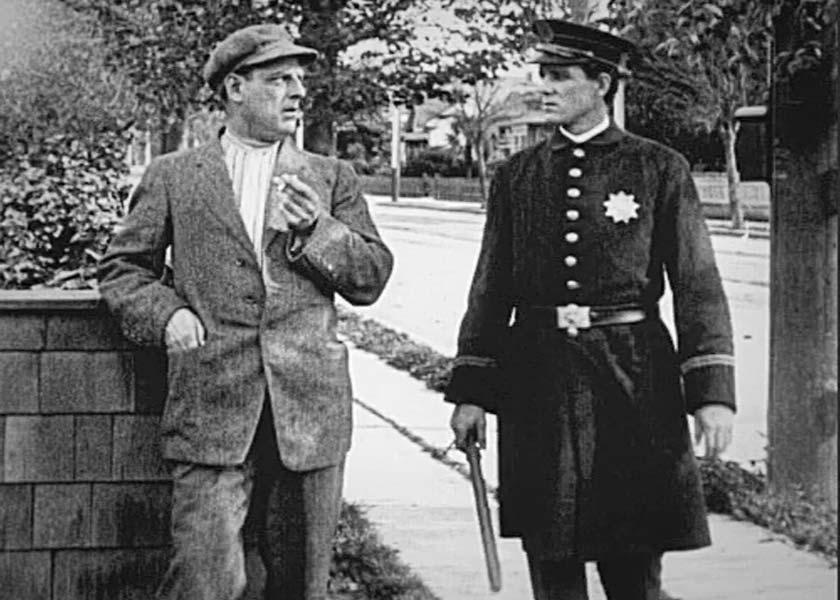Synopsis
The Regenerate (Anderson) pawns his stolen jewels to a pawnbroker. In the dance hall next door, the Customer (Chaplin) flirts with a pretty girl until her muscular boyfriend appears. The Customer flees up the stairs. Later, the Customer falls over the dancers and is thrown out of the dance hall. Slumming members of the upper class, two men and a young woman, the Girl (Clayton), all in evening clothes, sit in the balcony and watch the lower class dancers on the floor below. The Regenerate enters the dance hall and sits with a woman at a table. The man with the woman objects, and they fight. The man pulls a gun and shoots the Regenerate. The Girl rushes down from the balcony and uses her handkerchief to stop the bleeding. The police arrive and take the Regenerate away.
On a later night, the Regenerate and his partner (Willard) break into a house and open the safe. The Girl, who is sleeping in the next room, hears a noise and investigates. She sees them, and the Regenerate recognizes the woman who helped him. He refuses to take her jewelry. His partner objects, and they fight. The partner pulls out a gun, and the Regenerate accidentally shoots him. The Girl's maid (Applegate) has called the police. As the police arrive, the Girl tells the Regenerate to hide in her room. She takes the gun and tells the policemen that she shot the dead thief who had attacked her.
The Regenerate, hearing her lie for his sake, writes The Girl a note expressing gratitude. She has saved him from twenty years in prison. He pledges that he will make himself worthy of her. Outside the house, a policeman passes the now reformed Regenerate who watches placidly and walks away.
Discussion
Gilbert M. 'Broncho Billy' Anderson wrote, directed and starred in about 375 short
films for his studio Essanay Film Manufacturing Company from 1908-15. The quick
production of large numbers of films to satiate movie-hungry audiences meant that
time and inspiration for the development of complex stories and characters was
unavailable. His Regeneration , with its one-dimensional characters
and simplistic plot, is a good example of the films resulting from this assembly
line of mass film production. Cliché plot elements abound: a criminal being
saved by an act of kindness, and slumming
members of the upper class
visiting a lower class cafe or dance hall. Although techniques in camerawork,
editing, and blocking (how actors move within a scene) were advancing at the time,
particularly in the films of D.W. Griffith, Anderson's methods did not
significantly progress.
Anderson and his partner George K. Spoor formed Peerless Film Manufacturing Company in 1907, later changing the name to Essanay (as a play on their initials S and A). The company, headquartered in Chicago, specialized in comedies but soon began producing Westerns. Anderson traveled to Texas, Colorado, and California to make his films with authentic western backgrounds. In 1912, Anderson established the Essanay-West Company and built a studio in Niles, California (about twenty miles southeast of San Francisco), to take advantage of the local scenery, especially the picturesque Niles Canyon. Essanay-West produced 350 short films at the Niles studio, including many 'Broncho Billy' Westerns. Anderson left Essanay and sold his interest to Spoor in January 1916. The Niles studio was shut down the next month.
Anderson is best known in the character of 'Broncho Billy', the first Western movie star. In western or contemporary garb, Anderson was an unlikely star, not handsome in face or figure and lacking subtlety in his acting. He had, however, a rough-edged charm and forcefulness that seem to have been sufficient in the earliest period of filmmaking. Anderson withdrew from films after 1920, when younger and handsomer men were the public favorites, and audiences expected more depth and complexity in story and performance than Anderson could achieve.
Charles Chaplin signed with Essanay in December, 1914. He spent a year with the studio and made fourteen films in Chicago and Niles. Presumably, Chaplin took part in His Regeneration for fun or as a favor to Anderson, who had appeared in Chaplin's The Champion. Chaplin's appearance involves a brief bit of amusing slapstick unrelated to the main plot. He does not interact with Anderson who enters after Chaplin has been ejected from the dance hall.

